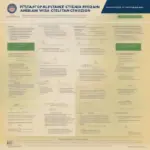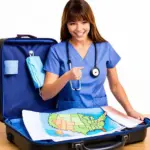Remember that incredible trip my friend took to Paris last spring? The Eiffel Tower sparkling at night, croissants for breakfast in charming cafes… It all seemed so effortless. That’s the magic of Europe!
Planning a European adventure yourself but feeling overwhelmed with what to prepare? Don’t worry, we’ve got you covered. From visa requirements to packing essentials and hidden travel gems, this guide will tell you everything you need for an unforgettable journey through the continent.
Essential Documents: Your Ticket to Europe
Before you even think about packing your suitcase, let’s talk about the documents that will get you there.
Passport and Visas:
- Passport: Ensure your passport is valid for at least six months beyond your intended stay. Trust me, the last thing you want is to be turned away at the airport!
- Visa (Schengen Visa): If you’re planning to visit the Schengen Area (26 European countries), you might need a Schengen Visa. This allows you to travel freely within these countries for up to 90 days. Check the specific requirements based on your nationality. For more information on visa requirements, visit our detailed guide: Do You Need a Visa to Travel to Europe?
Travel Insurance: Your Safety Net Abroad
Travel insurance is non-negotiable, folks! It protects you against unexpected medical emergencies, lost luggage, and other travel mishaps. Don’t leave home without it.
Flight and Accommodation Bookings:
Having your flight and accommodation bookings sorted in advance ensures a smooth and stress-free trip. Plus, it’ll give you peace of mind knowing you have a place to rest your head after a long day of exploring.
Packing Smart: Essentials for Every Traveler
Now, let’s talk about packing! Here’s a handy checklist to make sure you have everything you need:
Clothing:
- Comfortable walking shoes are crucial, especially if you plan on exploring cobblestone streets and charming alleyways.
- Pack for all types of weather, even if you’re traveling during the supposed “sunny” season. Europe is known for its unpredictable weather!
- Don’t forget a stylish scarf or two – they’re perfect for layering and adding a touch of elegance to any outfit.
- A lightweight jacket or sweater is a must-have for chilly evenings.
- Pack a mix of casual and dressy outfits to suit different occasions. You might find yourself enjoying a fancy dinner in Rome one night and exploring ancient ruins the next!
Essentials:
- Universal Adapter: Europe uses different plug sockets than many other parts of the world. A universal adapter will be your best friend!
- First-aid Kit: Pack a small first-aid kit with essentials like band-aids, pain relievers, and any personal medications.
- Portable Charger: Don’t let a dead phone ruin your picture-perfect moments. A portable charger will keep you powered up on the go.
Bonus Tip: Remember that less is more! Packing light will make your travels so much easier, especially if you plan on using public transportation or hopping between cities.
Imagine yourself strolling through a charming Parisian street, the scent of freshly baked bread filling the air. paris-street-scene|Charming Parisian Street|A photo showcasing a Parisian street scene with cobblestone roads, quaint cafes, and people strolling along the sidewalks. The scene should be filled with a sense of charm and vibrancy, capturing the essence of Parisian life. The photo can include a cafe with outdoor seating, a flower stand, and passersby, creating a lively atmosphere. This is just a glimpse of the magic that awaits in Europe.
Planning Your Itinerary: From Iconic Landmarks to Hidden Gems
Europe is a treasure trove of history, culture, and natural beauty. To make the most of your trip, it’s a good idea to have a rough itinerary in mind.
Must-See Destinations:
- Paris: The City of Lights needs no introduction. Explore iconic landmarks like the Eiffel Tower and the Louvre Museum, stroll along the Seine River and indulge in delicious pastries at local patisseries.
- Rome: Immerse yourself in history at the Colosseum and the Roman Forum, toss a coin in the Trevi Fountain, and savor authentic Italian pasta in Trastevere.
- Barcelona: Marvel at Gaudi’s architectural masterpieces, soak up the sun on Barceloneta Beach, and experience the vibrant nightlife scene.
- Amsterdam: Explore the charming canals, visit the Anne Frank House, and admire the masterpieces at the Rijksmuseum.
Off-the-Beaten-Path Adventures:
- Porto, Portugal: Discover the charm of this coastal city with its colorful buildings, delicious Port wine, and stunning views of the Douro River.
- Ljubljana, Slovenia: Explore the fairytale-like city center, wander through Tivoli Park, and take a boat ride along the Ljubljanica River.
- Budapest, Hungary: Relax in the city’s famous thermal baths, admire the Hungarian Parliament Building, and savor traditional Hungarian cuisine.
Travel Tip from Expert: “Embrace spontaneity! While it’s great to have a plan, don’t be afraid to deviate from it and discover hidden gems along the way.” – Anna Petrova, author of “The Wandering Soul’s Guide to Europe”
Imagine yourself standing in front of the Colosseum, its ancient grandeur towering over you. colosseum-roma|Colosseum in Rome|A majestic shot of the Colosseum, capturing its imposing structure and historical significance. The photo should showcase the grandeur of the ancient amphitheater, with its towering arches and weathered stones. It could also depict people visiting the site, adding a sense of scale and human interaction. The history of Europe is tangible, waiting to be explored.
Money Matters: Budgeting for Your European Adventure
Europe can be as budget-friendly or as luxurious as you make it. Here are some tips for managing your finances:
- Currency: The Euro (€) is the official currency of 19 European countries. If you’re traveling to countries outside the Eurozone, you’ll need to exchange currency.
- ATMs: ATMs are widely available throughout Europe, making it easy to access cash. However, be aware of foreign transaction fees.
- Credit Cards: Major credit cards are widely accepted. However, it’s always a good idea to carry some cash for smaller establishments and emergencies.
For a detailed guide on budgeting for your trip, check out our article: How Much Money Do You Need to Travel Europe?
Staying Connected: Calling, Data, and Wi-Fi
Staying connected in Europe is easier than ever before:
- SIM Cards: Consider getting a local SIM card for affordable data and calling options.
- Wi-Fi: Most hotels, cafes, and restaurants offer free Wi-Fi.
- Roaming: Check with your mobile provider about international roaming plans to avoid hefty charges.
Cultural Etiquette: Blending In Like a Local
- Greetings: In most European countries, a handshake is the customary greeting.
- Table Manners: It’s considered polite to keep your hands above the table while dining.
- Tipping: Tipping is customary in most European countries, but the amount varies.
- Language: While English is widely spoken, learning a few basic phrases in the local language will be greatly appreciated.
Imagine yourself savoring a delicious Italian meal, surrounded by the warmth of a traditional trattoria. italian-trattoria|Italian Trattoria|A photo depicting a cozy Italian trattoria, showcasing its warm ambiance, rustic decor, and delicious food. The photo could include patrons enjoying a meal, a chef preparing a dish, or a table setting with fresh ingredients, capturing the charm and authenticity of Italian dining. Food is a big part of European culture, and it’s one of the best ways to experience its diversity.
Embracing the Unexpected: Tips for a Smooth Journey
- Be Prepared for Delays: Delays can happen, so pack your patience and have a backup plan.
- Learn Basic Phrases: Knowing a few basic phrases in the local language can go a long way.
- Stay Safe: Be aware of your surroundings and take necessary precautions to protect yourself from theft.
- Most Importantly: Have Fun!
FAQs About Traveling to Europe
Do I need a COVID-19 vaccine to travel to Europe?
Vaccination requirements vary depending on your nationality and the specific European country you’re visiting. For the most up-to-date information, visit our detailed guide: Do You Need a COVID Vaccine to Travel to Europe?
What is the best time to travel to Europe?
Europe is beautiful year-round, but the best time to visit depends on your preferences. Spring and fall offer pleasant weather and fewer crowds, while summer is peak season with vibrant festivals and warm temperatures. Winter is perfect for skiing and experiencing the magic of Christmas markets.
What are some unique souvenirs to bring back from Europe?
From handcrafted ceramics in Portugal to exquisite chocolates in Switzerland, Europe offers a wide array of unique souvenirs. Look for locally made crafts, regional delicacies, and vintage treasures to remember your trip by.
Is it safe to drink tap water in Europe?
Tap water is generally safe to drink in most European countries. However, it’s always a good idea to double-check or opt for bottled water if you have any concerns.
Ready to Embark on Your European Adventure?
Europe awaits with open arms and endless possibilities! From the romance of Paris to the ancient wonders of Rome, there’s a destination for every traveler. With careful planning, a spirit of adventure, and a dash of wanderlust, your European journey is bound to be an experience of a lifetime.
Start planning your dream trip today! Explore our website for more travel inspiration, tips, and itineraries. Visit us at travelcar.edu.vn to discover the best of Europe.

